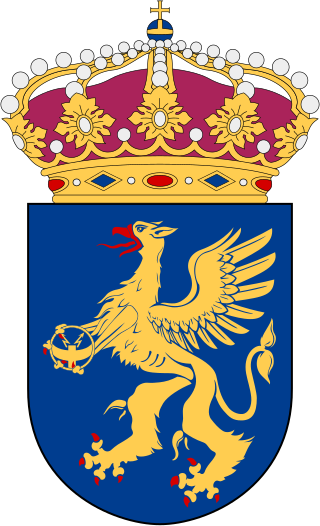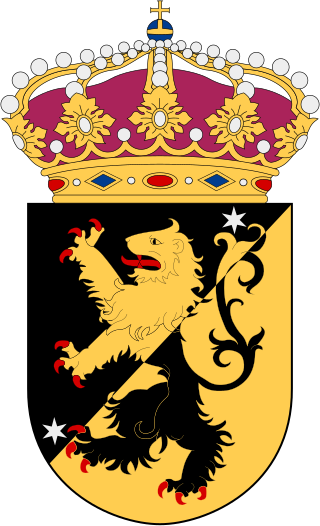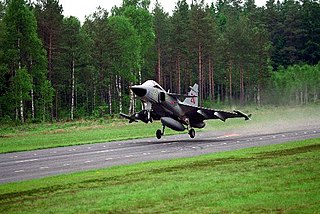Related Research Articles
Western Military District, originally III Military District was a Swedish military district, a command of the Swedish Armed Forces that had operational control over Western Sweden, for most time of its existence corresponding to the area covered by the counties of Gothenburg and Bohus, Älvsborg, Skaraborg and Halland. The headquarters of Milo V were located in Skövde.

[Swedish] Tactical and Air Defence Control System in forms of STRIL 50 and STRIL 60 were integrated systems for aerial warfare control including early warning radar and ground-controlled interception. The systems depended on radar and radio as primary technologies but STRIL 50 was based on manual control while STRIL 60 applied the usage of early digital computers.

The Göta Signal Corps, designations S 1 Sk and S 2, was a Swedish Army signal unit, one of the few new formations raised in the 20th century. It was disbanded in 1997. The unit was garrisoned in Västergötland.

Västgöta Wing, also F 6 Karlsborg, or simply F 6, is a former Swedish Air Force wing with the main base located near Karlsborg in south-central Sweden.

The Göta Logistic Regiment, is the only logistic regiment in the Swedish Armed Forces. Its new organisation was laid down in 2000, when the regiment became the only logistic regiment in Sweden. The regiment is located to Skövde.

The Chief of Navy is the most senior appointment in the Swedish Navy. The position Chief of Navy was introduced in 1936 and the current form in 2014.

Chief of Air Force is the most senior appointment in the Swedish Air Force. The position Chief of Air Force was introduced in 1926 and the current form in 2014.

General Sten Bengt Gustaf Gustafsson was a Swedish Army officer. He served as the Supreme Commander of the Swedish Armed Forces from 1986 to 1994.
The First Air Group, previously named Air Group and later named Attack Group was an air group unit in the Swedish Air Force. The First Air Group was the collective name given to the attack wings who would jointly carry out heavier attacks in the event of war. It was active in various formations from 1938 to 1995. It was directly subordinate to the Supreme Commander of the Swedish Armed Forces and therefore nicknamed ÖB:s klubba.

Bas 90 was an air base system used by the Swedish Air Force during the Cold War. Bas 90 was developed during the 1970s and 1980s from the existing Bas 60 system in response to the new threats and needs that had arisen since the conception of the Bas 60 system during the 1950s. Like its predecessor, the Bas 90 system was based around defensive force dispersal of aircraft across many krigsflygbaser in case of war, as well as dispersion of the air base functions within the individual bases themselves. The air units would have been dispersed so one squadron would be stationed per krigsflygbas. The system was a protective measure against nuclear weapons and airstrikes, the purpose being to make it complicated for an opponent to destroy the Swedish Air Force on the ground and thus ensure endurance for the air force in a conflict scenario.
The Defence Act of 2000 was a defence act passed by the Swedish Riksdag on 30 March 2000, and the largest reorganisation of the Swedish Armed Forces since the Defence Act of 1925. The act was a continuation of the policies set in motion by the Defence Act of 1996: shifting the military's focus from the defence of Swedish territory to a more flexible "operational defence* for smaller-scale peacekeeping operations in foreign nations. Many military formations were disbanded as a result.
The Defence Act of 1925 was a defence act passed by the Swedish Riksdag on 26 May 1925 and came into force on 1 January 1928. The Act specified how the Swedish Armed Forces would operate during the coming years. The Act resulted in a policy of disarmament. The Act would remain effective until the Defence Act of 1936.
A Defence Act is an act passed by the Swedish Riksdag every four years which details how the Swedish Armed Forces will function and develop during the coming years.
Stockholm Defence District, was a Swedish defence district which operated from 1939 to 2000. Fo 44 was responsible for the defence of Stockholm and its key task was to protect the national Swedish administration, that is, the head of state (king), parliament and the Swedish government.

The Chief of the Defence Staff the second most senior uniformed member of the Swedish Armed Forces and heads the Defence Staff. The Chief of the Defence Staff is the chief of staff of the Supreme Commander of the Swedish Armed Forces.
The Defence District Commander within the Swedish Armed Forces was a senior commanding officer who led forces in a geographical/military territorial district, or within a specific area of responsibility. The post was created in 1942 in connection with the Defence Act of 1942 and was terminated in 2000 through the Defence Act of 2000.

The Chief of the Army Staff is the professional head of the Swedish Army Staff. The post was created in 1936 with colonel Helge Jung as the first incumbent. The post disappeared in 1994 and was reintroduced in 2019 when the new Army Staff was established.

The Chief of the Air Staff is the professional head of the Swedish Air Staff. The post was created in 1936 with lieutenant colonel Bengt Nordenskiöld as the first incumbent. The post disappeared in 1994 and was reintroduced in 2019 when the new Air Staff was established.

Major General Erik Gustav Vilhelm Nygren was a Swedish Air Force officer. Nygren's senior command was Chief of the Air Staff from 1978 to 1980 and commanding officer of the Attack Group from 1980 to 1983.
Lieutenant General Karl (Carl) Erik Björeman was a senior Swedish Army officer. Björeman served as Chief of Staff of the Southern Military District (1980–1984), and as Commanding General of the Southern Military District (1984–1988).
References
- ↑ "Historisk monetär statistik för Sverige" [Historical monetary statistics for Sweden] (in Swedish). Sveriges Riksbank. 2018-02-01. Retrieved 19 March 2018.
- ↑ Glimvall, Peter (2001-05-21). "Svensk anpassningspolitik under 1900-talet - Ett säkerhetspolitiskt vågspel?" (PDF) (in Swedish). Swedish Defence University . Retrieved 5 March 2018.
- ↑ Högman, Hans (24 March 2013). "Kongl Södermanlands Regemente". Algonet. Archived from the original on 6 September 2014. Retrieved 5 March 2018.